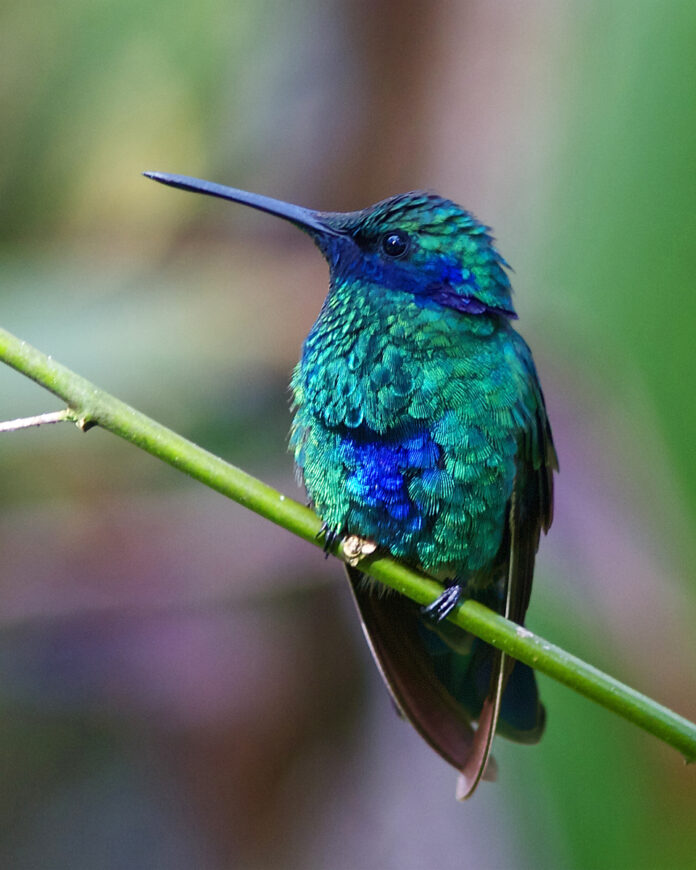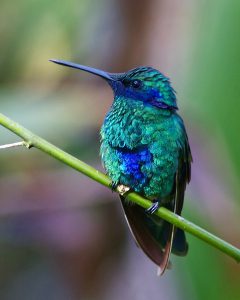
BY HARRY WEEKES

I am sitting on the left shoulder of Imbabura, a 15,000-foot stratovolcano in the northern Ecuadorian highlands, having taken the place of one of our trip leaders for our seniors’ final field study. It is the end of May and, after an afternoon of eating cuy con papas y ensalada (Guinea pig with potatoes and salad), and fumbling through broken Spanish, I strolled outside to “catch a hummingbird”—my offhanded phrase for doing a little birding in the garden.
It didn’t take long before the heavy buzz of a bird in flight drew me in. Drew me in to a disorienting vortex of ignorance. OK, maybe it wasn’t that bad (I blame the rarefied air of the Andes and the interesting feeling of being nestled amongst three volcanoes for drawing out a certain hyperbole). But the ignorance was real and stark
In the nearly 800-page “Birds of Ecuador” book at our inn, 54 pages are dedicated to hummingbirds. The hummingbirds themselves are nestled between the “Swifts” and “Trogons and Quetzals.” Trogons and Quetzals? These are birds that are either totally unfamiliar to me, or which flit across my mindscape in a vaguely cartoon way. The good thing is, seeing their names put me in a fictional state of mind and prepared me to flip through the pages on hummingbirds, which read as much like a casting call for a movie on mythical woodland beings as anything else: Bronzy Hermit, Band-tailed Barbthroat, Black-thighed Puffleg, Shining Sunbeam.
It didn’t take long to realize that not only was I not in Idaho anymore, but also that it was going to be incredibly difficult to identify anything here. This dovetailed nicely with a thought I was having about my difficulties with Spanish. As a 50-year-old, I tend not to “think simply.” In other words, when I am eating fried cuy, my thoughts range to things like, “What is the gestation period of a Guinea pig?” “How many babies are in a litter?” “How does one go about being a Guinea pig rancher?” Suffice to say, translating these ideas into conversation is a bit out of my linguistic range.
This made me realize how important it is to inhabit a real beginner’s mind. In language, that’s thinking of the simplest thing. “This is good.” “I like potatoes.” “Thank you.”
In birding, it’s not starting with a hundred tropical hummingbirds and working to distinguish the white-whiskered, green, and tawny-bellied hermits. It’s turning the cartoon of thought (“hummingbird”) into a cartoon on paper and writing things like: Hummingbird. Big. Greenish. Purply around the head. And even this simplicity masks the most important starting point—sitting outside and just being with things.
Sometimes, this is just sitting and being comfortable talking like an adult baby. Other times, it is just sitting and looking at really general characteristics and qualities and building from there. The Sparkling Violetear is a big hummingbird. It buzzes and chirps in gardens and open spaces along the entire spine of the Ecuadorian Andes. From its prominent perch it will routinely make buzzing flights and then return.
Sitting in the garden, the bird was like a little idea—perched on a high branch. The little idea took flight and I stared at the now-empty space. Several seconds later, the bird landed on the same perch. Orejivioleta Ventriazul. The Sparkling Violetear. Hummingbird. A simple hummingbird.
Harry Weekes is the founder and head of school at The Sage School in Hailey. This is his 47th year in the Wood River Valley, where he lives with his wife Hilary and their three kids—Georgia, Penelope and Simon—a nice little flock.


